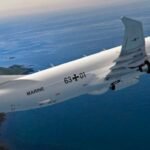The UK and Germany’s recent agreement marks a significant enhancement in defense collaboration, positioning German P-8 Poseidon maritime patrol aircraft to operate from Scotland. This move promises to bolster efforts in countering Russian naval activities, addressing a pressing concern in the North Atlantic.
The Trinity House Agreement, signed last week, formalizes this cooperation between the UK and German defense ministries. While the integration of German Poseidons into Scottish bases is not entirely new, it solidifies an ongoing partnership. This arrangement is a strategic step that enhances the operational efficiency of both nations in monitoring potential threats posed by Russian submarines.
A New Era of Maritime Surveillance
The P-8 Poseidon, manufactured by Boeing, is based on the 737 airframe, designed for extended missions over vast oceanic stretches. With its ability to conduct anti-submarine warfare, this aircraft represents a crucial upgrade in the UK’s maritime capabilities. The UK’s original maritime patrol fleet, the Nimrod MR2, was retired after years of delays and budget overruns, culminating in the cancellation of the MRA4 program in 2011.
During that void, the UK had to rely on allied support to fill the gap, which proved operationally restrictive. Today, however, the P-8s are equipped with advanced technology, offering a cost-effective solution compared to the MRA4. These planes play a pivotal role in detecting and tracking submarines, especially given the resurgence of Russian naval capabilities.

Key Features of the P-8 Poseidon
The P-8 is equipped with a plethora of features that enhance its maritime surveillance capabilities, including:
- Advanced Radar: Covers extensive sea areas and can detect surface ships and diesel submarines.
- Sonobuoy Deployment: The aircraft can drop up to 129 sonobuoys, which can passively listen for or actively ping submarines.
- Combat Capabilities: While primarily focused on surveillance, the P-8 can also deploy torpedoes against identified threats.
The integration of these capabilities allows for a comprehensive approach to submarine detection. It’s a collaborative effort that requires seamless coordination between air, land, and sea assets. This partnership is not just beneficial for the UK and Germany; it also addresses broader security concerns in the region.
The Russian Submarine Threat
The heightened activity of Russian submarines in the North Atlantic underscores the need for advanced monitoring capabilities. Russian naval forces, while facing challenges with their surface fleet, have improved their submarine operations significantly. Today’s Russian submarines are quieter and more capable than in previous decades, posing a real threat to Western naval operations.
Incorporating German Poseidons into this equation adds valuable resources to the UK’s maritime defense strategy. Effective submarine detection relies on an integrated network of assets. The P-8s enhance the UK’s ability to monitor the waters surrounding critical infrastructure, such as transatlantic data cables and offshore energy resources.
- Key concerns regarding Russian submarines include:
- Potential disruption of critical underwater infrastructure.
- Strategic deterrence against missile attacks on the UK mainland.
- Continuous monitoring of naval activities in sensitive areas.
By improving maritime patrol capabilities, the UK can ensure that its strategic deterrent submarines remain concealed and effective.
The Importance of Enhanced Data Capabilities
Despite the advantages the P-8 brings, the UK’s current fleet remains limited. With only nine operational aircraft, there are concerns about whether this is sufficient to address the growing threats in the North Atlantic. Historical context shows that during the Cold War, the UK operated nearly five times as many Nimrod aircraft.
Moreover, the P-8’s ability to process and share data is not on par with its American counterparts. The U.S. P-8s are integrated into a secure real-time data network, allowing for efficient information exchange during operations. The UK’s P-8s, however, still rely on outdated systems that require landing to download crucial operational data.
| Capability | UK P-8 Poseidon | U.S. P-8 Poseidon |
|---|---|---|
| Operational Fleet | 9 | 117 |
| Real-Time Data Transfer | Limited | Advanced |
| Weapons Options | Limited to torpedoes | Variety of missiles |
This disparity highlights the need for investment in technology upgrades, particularly in secure communications and data transfer capabilities. The enhancement of these features would significantly bolster operational effectiveness.
Strengthening Alliances for Future Operations
The Trinity House Agreement is more than just a strategic partnership; it symbolizes a commitment to collective defense in the face of common threats. Germany’s presence in Scottish airspace reinforces the idea that cooperation is vital in ensuring maritime security.
The potential for further collaboration is promising. This could lead to joint training exercises, intelligence sharing, and perhaps even the development of autonomous systems that complement the capabilities of the Poseidon fleet. As NATO strengthens its collective security framework, these alliances become crucial in deterring adversaries.
In light of the growing challenges in the North Atlantic, increasing the number of P-8s and enhancing their capabilities should be a priority. The hope is that the latest agreement will drive home the message that a robust maritime defense is not just desirable but essential for national security.


















